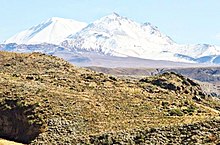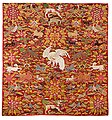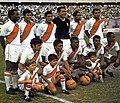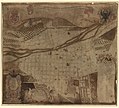Portal:Peru
Introduction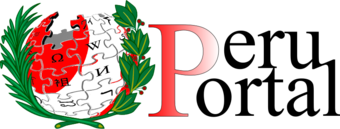
Peru, officially the Republic of Peru, is a country in western South America. It is bordered in the north by Ecuador and Colombia, in the east by Brazil, in the southeast by Bolivia, in the south by Chile, and in the south and west by the Pacific Ocean. Peru is a megadiverse country with habitats ranging from the arid plains of the Pacific coastal region in the west to the peaks of the Andes mountains extending from the north to the southeast of the country to the tropical Amazon basin rainforest in the east with the Amazon River. Peru has a population of over 32 million, and its capital and largest city is Lima. At 1,285,216 km2 (496,225 sq mi), Peru is the 19th largest country in the world, and the third largest in South America. Peruvian territory was home to several cultures during the ancient and medieval periods, and has one of the longest histories of civilization of any country, tracing its heritage back to the 10th millennium BCE. Notable pre-colonial cultures and civilizations include the Caral–Supe civilization (the earliest civilization in the Americas and considered one of the cradles of civilization), the Nazca culture, the Wari and Tiwanaku empires, the Kingdom of Cusco, and the Inca Empire, the largest known state in the pre-Columbian Americas. The Spanish Empire conquered the region in the 16th century and Charles V established a viceroyalty with the official name of the Kingdom of Peru that encompassed most of its South American territories, with its capital in Lima. Higher education started in the Americas with the official establishment of the National University of San Marcos in Lima in 1551. Peru's population includes Mestizos, Amerindians, Europeans, Africans and Asians. The main spoken language is Spanish, although a significant number of Peruvians speak Quechuan languages, Aymara, or other Indigenous languages. This mixture of cultural traditions has resulted in a wide diversity of expressions in fields such as art, cuisine, literature, and music. (Full article...) Entries here consist of Good and Featured articles, which meet a core set of high editorial standards.
Tutupaca is a volcano in the region of Tacna in Peru. It is part of the Peruvian segment of the Central Volcanic Zone, one of several volcanic belts in the Andes. Tutupaca consists of three overlapping volcanoes formed by lava flows and lava domes made out of andesite and dacite, which grew on top of older volcanic rocks. The highest of these is usually reported to be 5,815 metres (19,078 ft) tall and was glaciated in the past. Several volcanoes in Peru have been active in recent times, including Tutupaca. Their volcanism is caused by the subduction of the Nazca Plate beneath the South America Plate. One of these volcanoes collapsed in historical time, probably in 1802, generating a large debris avalanche with a volume likely exceeding 0.6–0.8 cubic kilometres (0.14–0.19 cu mi) and a pyroclastic flow. The associated eruption was among the largest in Peru for which there are historical records. The volcano became active about 700,000 years ago, and activity continued into the Holocene, but whether there were historical eruptions was initially unclear; some eruptions were instead attributed to the less eroded Yucamane volcano. The Peruvian government plans to monitor the volcano for future activity. Tutupaca features geothermal manifestations with fumaroles and hot springs. (Full article...)Selected image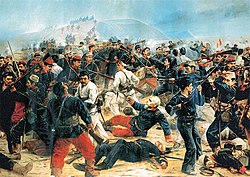 The Battle of Arica took place on June 7, 1880 during the War of the Pacific when Chilean forces led by Colonel Pedro Lagos attacked the port city of Arica, defended by a Peruvian garrison under the command of Colonel Francisco Bolognesi. After heavy fighting the battle ended with a Chilean victory and the death of several Peruvian high-ranking officers including Bolognesi and Alfonso Ugarte. This oil painting by Peruvian artist Juan Lepiani depicts Bolognesi's final moments. (more...) Selected battleThe Naval Battle of Iquique was a confrontation occurred on May 21, 1879; during the naval stage of the War of the Pacific, a conflict between Chile and the alliance between Peru and Bolivia. This battle took place on the shores of the Peruvian port of Iquique, where the Peruvian ironclad Huáscar, commanded by the Captain Miguel Grau Seminario sunk the Esmeralda, an old Chilean wooden corvette led by Captain Arturo Prat Chacón; after four hours of combat. This event has become one of the most emblematic battles of this war due to the glorification of the fallen Chilean captain Prat and Peruvian Captain Miguel Grau's noble gesture of saving the enemy crew and rescuing Prat's body. (more...) In this month
General imagesThe following are images from various Peru-related articles on Wikipedia.
Selected article - The mineral industry of Peru has played an important role in the nation's history and been integral to the country's economic growth for several decades. The industry has also contributed to environmental degradation and environmental injustice; and is a source of environmental conflicts that shape public debate on good governance and development. In 2019, the country was the 2nd largest world producer of copper, silver, and zinc; 3rd for lead, 4th of tin and molybdenum; 5th for boron; and 8th largest global producer of gold. (Full article...)Did you know (auto-generated) -
CategoriesRelated portalsSelected quote -
English art historian, writer, antiquarian and politician Horace Walpole 1717–1797
Basic facts & figuresMore did you know...
Peru TopicsRecognized content
Featured articlesFeatured listsGood articles
WikiProjectsThings you can do
New articlesThis list was generated from these rules. Questions and feedback are always welcome! The search is being run daily with the most recent ~14 days of results. Note: Some articles may not be relevant to this project.
Rules | Match log | Results page (for watching) | Last updated: 2024-05-13 21:47 (UTC) Note: The list display can now be customized by each user. See List display personalization for details.
Associated WikimediaThe following Wikimedia Foundation sister projects provide more on this subject:
Discover Wikipedia using portals | |||||||||||||||




